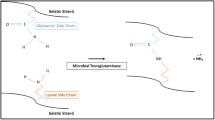Abstract
The need for a rapid and direct alternative to the rheology-based blending laws in quantifying phase behaviour in biopolymer composite gels is explored in this study. In doing so, the efficacy of confocal laser scanning microscopy (CLSM) paired with image analysis software – FIJI and Imaris - in quantifying phase volume was studied. That was carried out in a model system of agarose with varying concentrations of microcrystalline cellulose (MCC) in comparison to the rheological blending laws. Structural studies performed using SEM, FTIR, differential scanning calorimetry and dynamic oscillation in-shear unveiled a continuous, weak agarose network supporting the hard, rod-shaped MCC inclusions where the composite gel strength increased with higher ‘filler’ concentration. The phase volumes of MCC, estimated with the microscopic protocol, matched the predictions obtained from computerized modelling using the Lewis-Nielsen blending laws. Results highlight the suitability of the microscopic protocol in estimating the water partition and effective phase volumes in the agarose-MCC composite gel.







Similar content being viewed by others
References
K. Prameela, C.Murali Mohan, C. Ramakrishna, Chap. 1 - Biopolymers for Food Design: Consumer-Friendly Natural Ingredients, in Biopolymers for Food Design, ed. by A.M. Grumezescu, A.M. Holban (Academic Press, Cambridge, 2018), p. 1–32
C. Stenger et al., Formation of concentrated biopolymer particles composed of oppositely charged WPI and pectin for food applications. J. Dispersion Sci. Technol. 38(9), 1258–1265 (2017)
V. Tolstoguzov, Ionic strength and poly ion charges. Int. Food Ingred. 2, 8–9 (1990)
M.M.G. Koning, J. van Eendenburg, D.W. de Bruijne, Mixed Biopolymers in Food Systems: Determination of Osmotic Pressure, in Food Colloids and Polymers, ed. by E. Dickinson, P. Walstra (Woodhead Publishing. Cambridge, 2005), p. 103–112
T. Giancone et al., Protein–polysaccharide interactions: Phase behaviour of pectin–soy flour mixture. Food Hydrocoll. 23(5), 1263–1269 (2009)
P.D. Pudney, T.M. Hancewicz, D.G. Cunningham, The use of confocal Raman spectroscopy to characterise the microstructure of complex biomaterials: foods. J. Spectrosc. 16(3–4), 217–225 (2002)
L.E. Nielsen, in Morphology and the elastic modulus of block polymers and polyblends, in Rheological Theories· Measuring Techniques in Rheology Test Methods in Rheology· Fractures Rheological Properties of Materials· Rheo-Optics· Biorheology. (Springer, Berlin, 1975), p. 594–600
M. Takayanagi, H. Harima, Y. Iwata, Viscoelastic behaviour of polymer blends and its comparison with model experiments. Mem. Fac. Eng. Kyusha Univ. 23, 1–13 (1963)
X. Li et al., Studies of phase separation in soluble rice protein/different polysaccharides mixed systems. LWT Food Sci. Technol. 65, 676–682 (2016)
T. Moschakis et al., in Microrheology and microstructure of water-in-water emulsions containing sodium caseinate and locust bean gum. Food Funct. 9(5), 2840–2852 (2018)
H. Pan et al., Effect of the extent and morphology of phase separation on the thermal behavior of co-blending systems based on soy protein isolate/alginate. Food Hydrocoll. 52, 393–402 (2016)
N. Lorén, M. Langton, A.M. Hermansson, Confocal laser scanning microscopy and image analysis of kinetically trapped phase-separated gelatin/maltodextrin gels. Food Hydrocoll. 13(2), 185–198 (1999)
J.C.G. Blonk et al., A new CSLM-based method for determination of the phase behaviour of aqueous mixtures of biopolymers. Carbohyd. Polym. 28(4), 287–295 (1995)
P. Mhaske et al., Quantitative analysis of the phase volume of agarose-canola oil gels in comparison to blending law predictions using 3D imaging based on confocal laser scanning microscopy. Food Res. Int. 125, 108529 (2019)
J. Nsor-Atindana et al., Functionality and nutritional aspects of microcrystalline cellulose in food. Carbohyd. Polym. 172, 159–174 (2017)
N. Russ et al., Influence of nongelling hydrocolloids on the gelation of agarose. Biomacromolecules 14(11), 4116–4124 (2013)
C. Kyomugasho et al., Evaluation of cation-facilitated pectin-gel properties: Cryo-SEM visualisation and rheological properties. Food Hydrocoll. 61, 172–182 (2016)
X. Qi et al., Facile formation of salecan/agarose hydrogels with tunable structural properties for cell culture. Carbohyd. Polym. 224, 115208 (2019)
V. Zamora-Mora et al., Chitosan/agarose hydrogels: Cooperative properties and microfluidic preparation. Carbohydr. Polym. 111, 348–355 (2014)
C.P. Azubuike, A.O. Okhamafe, Physicochemical, spectroscopic and thermal properties of microcrystalline cellulose derived from corn cobs. Int. J. Recycl. Org. Waste Agric. 1(1), 9 (2012)
H. Toğrul, N. Arslan, Flow properties of sugar beet pulp cellulose and intrinsic viscosity–molecular weight relationship. Carbohyd. Polym. 54(1), 63–71 (2003)
M. Murigi et al., Comparison of physicochemical characteristics of microcrystalline cellulose from four abundant Kenyan biomasses. IOSR J. Polym. Text. Eng. 1(2), 53–63 (2014)
A.J. Gravelle, S. Barbut, A.G. Marangoni, Food-grade filler particles as an alternative method to modify the texture and stability of myofibrillar gels. Sci. Rep. 7(1), 11544 (2017)
C. Semasaka et al., Modeling water partition in composite gels of BSA with gelatin following high pressure treatment. Food Chem. 265, 32–38 (2018)
L.W. Koh, S. Kasapis, Orientation of short microcrystalline cellulose fibers in a gelatin matrix. Food Hydrocoll. 25(5), 1402–1405 (2011)
A.A. Karamitrou, G.N. Tsokas, M. Petrou, A pixel-based semi‐stochastic algorithm for the registration of geophysical images. Archaeol. Prospect. 24(4), 413–424 (2017)
T.Y. Goh et al., Performance analysis of image thresholding: Otsu technique. Measurement 114, 298–307 (2018)
Acknowledgements
The authors acknowledge the facilities and technical assistance of the RMIT University’s Microscopy and Microanalysis Facility.
Author information
Authors and Affiliations
Corresponding author
Additional information
Publisher’s Note
Springer Nature remains neutral with regard to jurisdictional claims in published maps and institutional affiliations.
Rights and permissions
About this article
Cite this article
Mhaske, P., Farahnaky, A. & Kasapis, S. 3D Confocal Laser Scanning Microscopy for Quantification of the Phase Behaviour in Agarose-MCC co-gels in Comparison to the Rheological Blending-law Analysis. Food Biophysics 16, 153–160 (2021). https://doi.org/10.1007/s11483-020-09656-6
Received:
Accepted:
Published:
Issue Date:
DOI: https://doi.org/10.1007/s11483-020-09656-6




